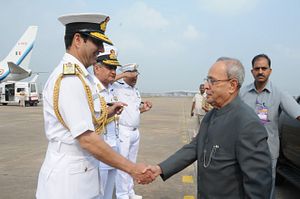The Indian Navy underlined its growing prowess at the International Fleet Review (IFR) 2016 last week. Though it was largely a ceremonial inspection of naval warships by the Indian president, it provided an opportunity to the Indian Navy to showcase its might and rapidly expanding capabilities. It was in 2001 that an event of such a scale was last held in India and since then the Indian Navy’s participating contingent has only grown bigger, with 75 frontline ships and submarines in attendance, in addition to 24 ships and delegations from over 50 nations including Australia, Bangladesh, Brazil, China, France, Indonesia, Iran, Maldives, the United Kingdom and the United States.
Flagging the threat of sea-borne terror and piracy as two key challenges to maritime security and underlining the need to respect freedom of navigation against the backdrop of South China Sea dispute, Indian Prime Minister Narendra Modi declared during the IFR that India will be hosting the first-ever Global Maritime Summit in April. He made it clear that the Indian Ocean region remains his government’s priority given India’s 1,200 island territories, and its huge exclusive economic zone of 2.4 million sq km. He further underlined the Indian Ocean region’s role “as a strategic bridge with the nations in our immediate and extended maritime neighborhood.” Underlining the need for a “modern and multi-dimensional Navy,” Modi stressed that India would continue to actively pursue and promote its geopolitical, strategic, and economic interests on the seas, in particular the Indian Ocean.
The Indian Navy has emerged as an indispensable tool of Indian diplomacy in recent years, making it imperative for Indian policy-makers and naval thinkers to think anew about the role of the nation’s naval forces in Indian strategy. Despite a general understanding among Indian political elites that it was the littoral dominance by the European powers that led to their colonial ascendancy in the Indian heartland, the focus on land frontiers led to the dominance of the Indian Army in the national security discourse.
Until the end of the Cold War, the maritime dimension of India’s security did not figure adequately in the national consciousness. Indian policy-makers did not perceive the advantage of building up the nation’s maritime sinews as the country remained concerned with the north and north-western frontiers after partition rather than with her sea frontiers. Yet despite the Indian Navy’s marginalization and the preoccupation of policymakers with safeguarding the integrity of nation’s land frontiers, the Indian Navy was largely successful in maintaining a credible naval force in the region.
Today, the Indian Navy’s original local sea control and shore defense orientation, which largely focused on preserving the integrity of Indian coastal waters from regional threats, has given way to a more ambitious naval posture. India’s naval policy is geared toward ensuring the freedom of navigation for shipping and safety of sea lines of communication as well as to safeguard its interests in contiguous waters, exclusive economic zone, and island territories. The Indian Navy would eventually like to emerge as a world-class blue-water force, equipped to meet regional challenges, and threats and to safeguard India’s maritime interests. India needs a blue water navy not only to meet naval threats from China and Pakistan, but also to exploit its strategic location at the center of the Indian Ocean as well as to protect its extensive exclusive economic zone.
There’s a long tradition in India of viewing the maritime dimension of security as central to nation’s strategic priorities. With India’s economic rise, New Delhi is trying to bring that focus back, making its navy integral to national grand strategy. While China remains a significant worry, the bigger problem remains one of introducing organizational changes and doctrinal evolution. How India manages these issues will be significant not only for the Indian Navy’s future but also for the rise of India as a credible global military power.

































